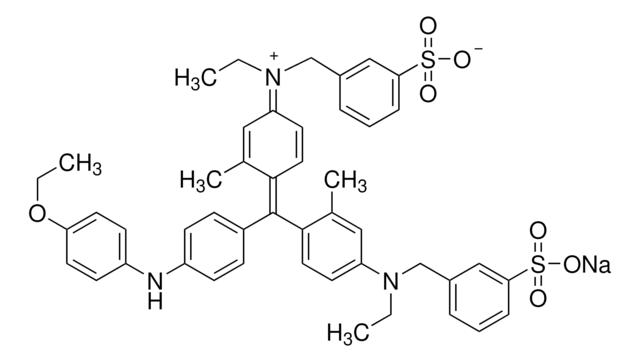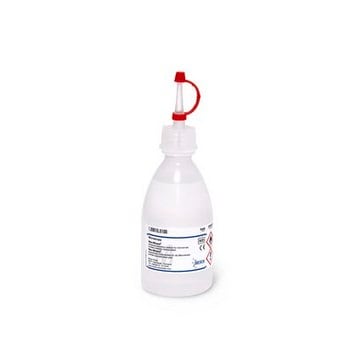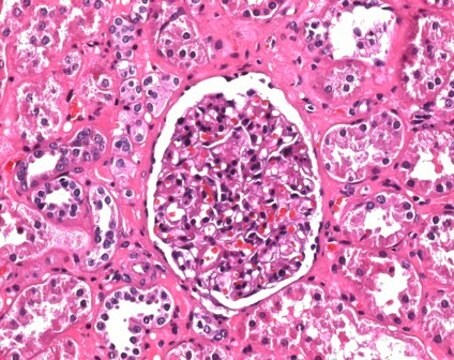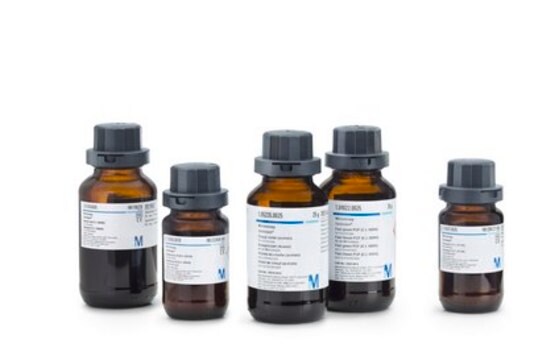C9368
CC/Mount™
tissue mounting medium
Synonyme(s) :
aqueous-based permanent mounting medium
Se connecterpour consulter vos tarifs contractuels et ceux de votre entreprise/organisme
About This Item
Code UNSPSC :
12171500
Nomenclature NACRES :
NA.47
Produits recommandés
Description générale
CC/Mount is an aqueous based permanent mounting medium with a very high refractive index, which when applied to the stained tissue sections can store the tissue specimens permanently without the fading of the chromogens. Because of the superior refractive index of CC/Mount, tissues mounted in this medium look like specimens mounted with organic based mounting media. No coverslipping is required with CC/Mount. However, if coverslipping is required, dried CC/Mount can be post mounted by using an organic based mounting medium. CC/Mount permits the long-term storage of antigens localized using organic insoluble chromogen substrates, including AEC, DAB, Fast Red, BCIP/NBT, BCIP/INT and fluorescent dyes like FITC and phycobiliproteins. The high pH of CC/Mount ensures increased stability of fluorescence intensity.
Application
CC/Mount is an aqueous based permanent mounting medium, similar to Crystal Mount™, for the permanent preservation of tissue sections stained with peroxidase and alkaline phosphatase based systems as well as with various fluorescent dyes.
Caractéristiques et avantages
- No need of coverslip
- No exposure to organic fumes
- Permanent storage of slides
- High resolution of tissue specimens.
Notes préparatoires
Storage: Store the product at room temperature. Do not refrigerate.
Remove the red end cap from the bottle and cut the tip off with a sharp razor or scissors. This will allow a smooth flow of CC/Mount and prevent formation of tiny bubbles because of squeezing.
Informations légales
CC/Mount is a trademark of Diagnostic BioSystems, Inc.
Crystal Mount is a trademark of Biomeda Corp.
Produit(s) apparenté(s)
Réf. du produit
Description
Tarif
Code de la classe de stockage
10 - Combustible liquids
Classe de danger pour l'eau (WGK)
WGK 1
Point d'éclair (°F)
Not applicable
Point d'éclair (°C)
Not applicable
Équipement de protection individuelle
Eyeshields, Gloves, type ABEK (EN14387) respirator filter
Certificats d'analyse (COA)
Recherchez un Certificats d'analyse (COA) en saisissant le numéro de lot du produit. Les numéros de lot figurent sur l'étiquette du produit après les mots "Lot" ou "Batch".
Déjà en possession de ce produit ?
Retrouvez la documentation relative aux produits que vous avez récemment achetés dans la Bibliothèque de documents.
Les clients ont également consulté
Heterogeneity of The CD90+ Population in Different Stages of Hepatocarcinogenesis.
Thakolwiboon S, et al.
Journal of Proteomics and Bioinformatics, 7(10), 296-296 (2014)
Immunohistochemical Detection of p53 Tumor Suppressor Protein in Round Cell Tumors of Dogs in Grenada, West Indies.
Tiwari K P, et al.
Advances in Animal and Veterinary Sciences, 2(3S), 23-27 (2014)
Tilman Grune et al.
Biotechnology journal, 13(5), e1700652-e1700652 (2018-01-11)
Large amounts of data from multi-channel, high resolution, fluorescence microscopic images require tools that provide easy, customizable, and reproducible high-throughput analysis. The freeware "ImageJ" has become one of the standard tools for scientific image analysis. Since ImageJ offers recording of
Saddam K Panezai et al.
The Journal of comparative neurology, 528(10), 1725-1741 (2020-01-01)
The paraflocculus and the neighboring smaller flocculus form a remarkable protrusion in the ventrolateral aspect of the mouse cerebellum, in which the longitudinal compartments are conspicuously oriented perpendicularly to the sagittal plane. The developmental process of such anatomical arrangements in
The Use of Sequential VEGF- and BMP2-Releasing Biodegradable Scaffolds in Rabbit Mandibular Defects.
Nilüfer Çakır-Özkan et al.
Journal of oral and maxillofacial surgery : official journal of the American Association of Oral and Maxillofacial Surgeons, 75(1), 221-221 (2016-10-25)
Promising developments have materialized in reconstructive surgical procedures with the applications of tissue engineering. In our study, we used tissue scaffolds fabricated from polylactic acid-polyethylene glycol (PLLA-PEG) copolymers to ensure different release rates of selective growth factors recombinant human bone
Notre équipe de scientifiques dispose d'une expérience dans tous les secteurs de la recherche, notamment en sciences de la vie, science des matériaux, synthèse chimique, chromatographie, analyse et dans de nombreux autres domaines..
Contacter notre Service technique












